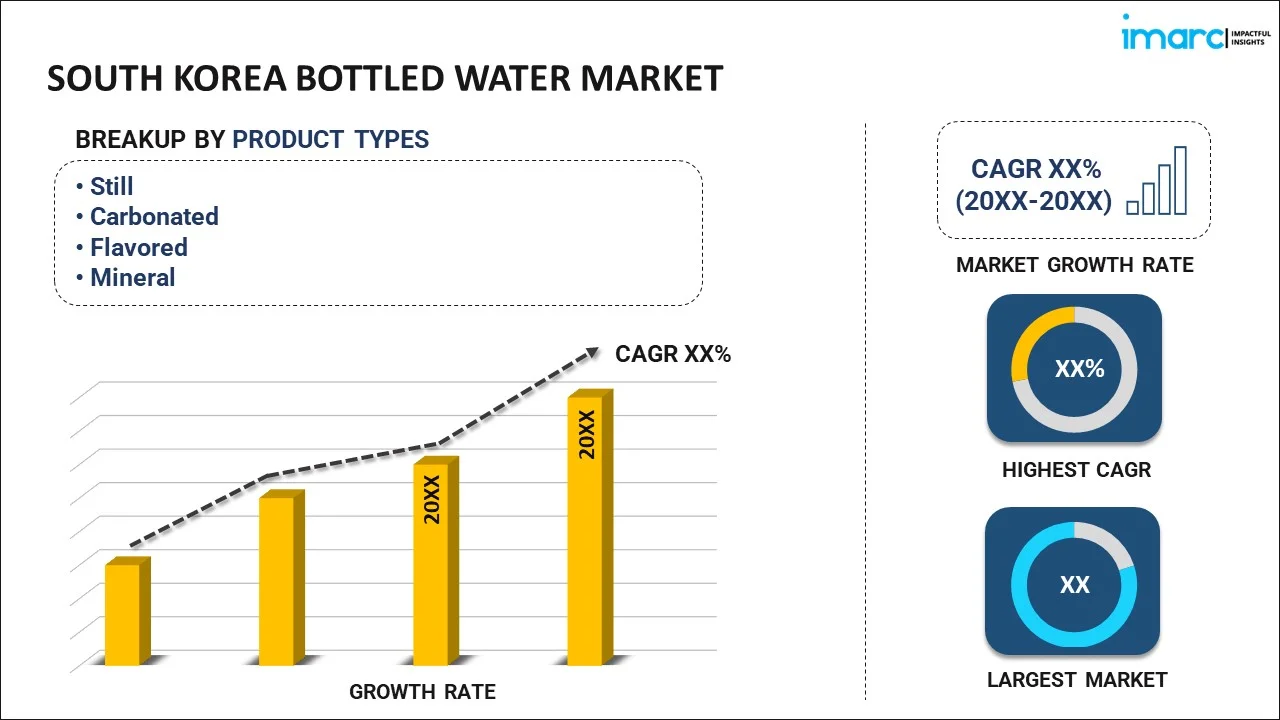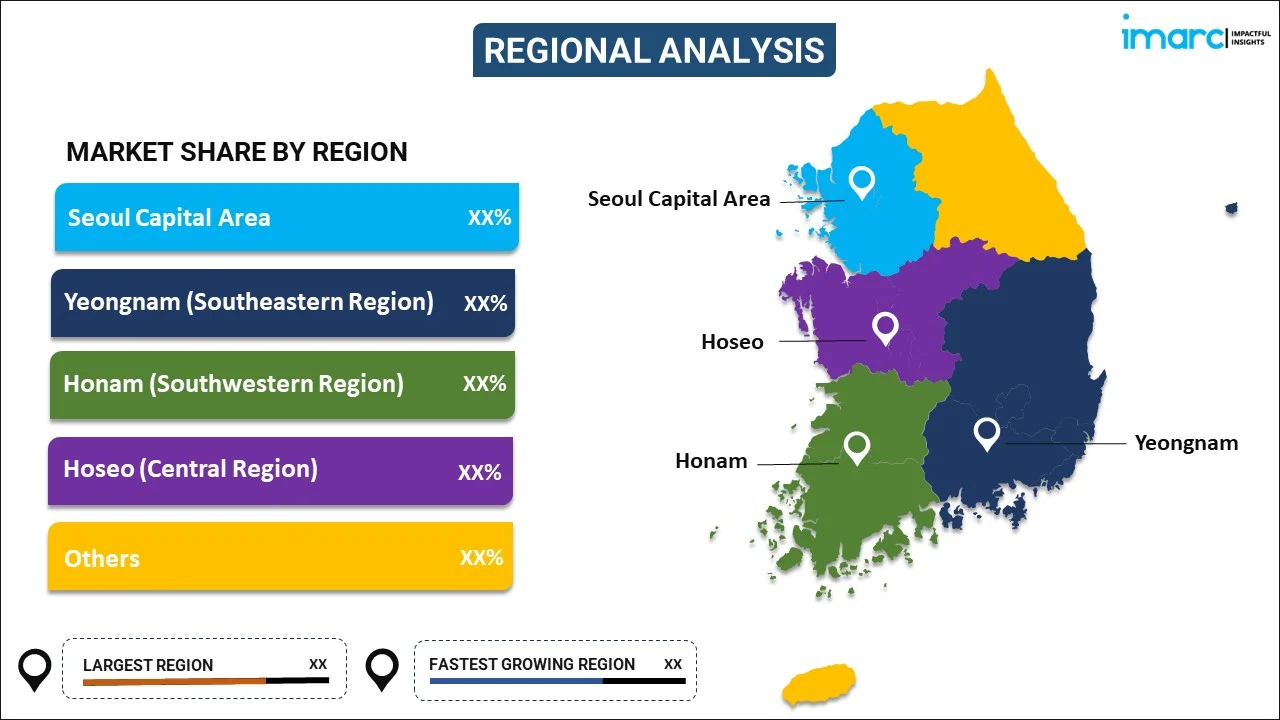
South Korea Bottled Water Market Report by Product Type (Still, Carbonated, Flavored, Mineral), Distribution Channel (Supermarkets and Hypermarkets, Convenience Stores, Direct Sales, On-Trade, and Others), Packaging Type (PET Bottles, Metal Cans, and Others), and Region 2024-2032
Market Overview:
South Korea bottled water market size is projected to exhibit a growth rate (CAGR) of 4.20% during 2024-2032. The rapid urbanization and changing lifestyles in South Korea, which have led to an increased demand for packaged and convenient products, including bottled water, is driving the market.
|
Report Attribute
|
Key Statistics
|
|---|---|
|
Base Year
|
2023
|
|
Forecast Years
|
2024-2032
|
|
Historical Years
|
2018-2023
|
| Market Growth Rate (2024-2032) | 4.20% |
Bottled water is derived from diverse sources like natural springs, wells, and municipal water systems, undergoing rigorous purification to eliminate contaminants such as bacteria, chemicals, and pollutants, guaranteeing its high quality. Through meticulous filtration processes, it ensures a clean and safe hydration experience. This portable beverage proves convenient for on-the-go use, readily available in settings like offices, gyms, and outdoor activities. Packaged in plastic, glass, or aluminum containers, it is distributed commercially and consumed by individuals. The stringent purification methods employed during production emphasize its commitment to quality, making it a reliable choice for those seeking a trustworthy and easily accessible hydration option. Whether for professional or recreational purposes, bottled water offers a versatile and clean solution for individuals in diverse environments.
South Korea Bottled Water Market Trends:
The bottled water market in South Korea has witnessed remarkable growth in recent years, fueled by various key drivers. Firstly, increasing health consciousness among consumers has been a pivotal factor driving the surge in demand for bottled water. As people become more aware of the importance of hydration and the potential health benefits associated with regular water consumption, they are inclined towards convenient and readily available bottled water options. Moreover, changing lifestyles and a growing focus on on-the-go convenience have significantly contributed to the market's expansion. Busy schedules and urbanization have led to a shift in consumer preferences towards portable and easily accessible hydration solutions, with bottled water emerging as a convenient choice for individuals leading fast-paced lives. Additionally, rising concerns about water quality and safety in certain regions have propelled consumers to opt for packaged water, perceived as a reliable and purified alternative. Furthermore, numerous marketing strategies that emphasize eco-friendly packaging and sustainable sourcing, thereby resonating well with environmentally conscious consumers, are expected to drive the bottled water market in South Korea during the forecast period.
South Korea Bottled Water Market Segmentation:
IMARC Group provides an analysis of the key trends in each segment of the market, along with forecasts at the country levels for 2024-2032. Our report has categorized the market based on product type, distribution channel, and packaging type.
Product Type Insights:

- Still
- Carbonated
- Flavored
- Mineral
The report has provided a detailed breakup and analysis of the market based on the product type. This includes still, carbonated, flavored, and mineral.
Distribution Channel Insights:
- Supermarkets and Hypermarkets
- Convenience Stores
- Direct Sales
- On-Trade
- Others
A detailed breakup and analysis of the market based on the distribution channel have also been provided in the report. This includes supermarkets and hypermarkets, convenience stores, direct sales, on-trade, and others.
Packaging Type Insights:
- PET Bottles
- Metal Cans
- Others
The report has provided a detailed breakup and analysis of the market based on the packaging type. This includes PET bottles, metal cans, and others.
Regional Insights:

- Seoul Capital Area
- Yeongnam (Southeastern Region)
- Honam (Southwestern Region)
- Hoseo (Central Region)
- Others
The report has also provided a comprehensive analysis of all the major regional markets, which include Seoul Capital Area, Yeongnam (Southeastern Region), Honam (Southwestern Region), Hoseo (Central Region) and Others.
Competitive Landscape:
The market research report has also provided a comprehensive analysis of the competitive landscape in the market. Competitive analysis such as market structure, key player positioning, top winning strategies, competitive dashboard, and company evaluation quadrant has been covered in the report. Also, detailed profiles of all major companies have been provided.
South Korea Bottled Water Market Report Coverage:
| Report Features | Details |
|---|---|
| Base Year of the Analysis | 2023 |
| Historical Period | 2018-2023 |
| Forecast Period | 2024-2032 |
| Units | US$ Million |
| Scope of the Report | Exploration of Historical and Forecast Trends, Industry Catalysts and Challenges, Segment-Wise Historical and Predictive Market Assessment:
|
| Product Types Covered | Still, Carbonated, Flavored, Mineral |
| Distribution Channels Covered | Supermarkets and Hypermarkets, Convenience Stores, Direct Sales, On-Trade, Others |
| Packaging Types Covered | PET Bottles, Metal Cans, Others |
| Regions Covered | Seoul Capital Area, Yeongnam (Southeastern Region), Honam (Southwestern Region), Hoseo (Central Region), Others |
| Customization Scope | 10% Free Customization |
| Report Price and Purchase Option | Single User License: US$ 3699 Five User License: US$ 4699 Corporate License: US$ 5699 |
| Post-Sale Analyst Support | 10-12 Weeks |
| Delivery Format | PDF and Excel through Email (We can also provide the editable version of the report in PPT/Word format on special request) |
Key Questions Answered in This Report:
- How has the South Korea bottled water market performed so far and how will it perform in the coming years?
- What has been the impact of COVID-19 on the South Korea bottled water market?
- What is the breakup of the South Korea bottled water market on the basis of product type?
- What is the breakup of the South Korea bottled water market on the basis of distribution channel?
- What is the breakup of the South Korea bottled water market on the basis of packaging type?
- What are the various stages in the value chain of the South Korea bottled water market?
- What are the key driving factors and challenges in the South Korea bottled water?
- What is the structure of the South Korea bottled water market and who are the key players?
- What is the degree of competition in the South Korea bottled water market?
Key Benefits for Stakeholders:
- IMARC’s industry report offers a comprehensive quantitative analysis of various market segments, historical and current market trends, market forecasts, and dynamics of the South Korea bottled water market from 2018-2032.
- The research report provides the latest information on the market drivers, challenges, and opportunities in the South Korea bottled water market.
- Porter's five forces analysis assist stakeholders in assessing the impact of new entrants, competitive rivalry, supplier power, buyer power, and the threat of substitution. It helps stakeholders to analyze the level of competition within the South Korea bottled water industry and its attractiveness.
- Competitive landscape allows stakeholders to understand their competitive environment and provides an insight into the current positions of key players in the market.
Need more help?
- Speak to our experienced analysts for insights on the current market scenarios.
- Include additional segments and countries to customize the report as per your requirement.
- Gain an unparalleled competitive advantage in your domain by understanding how to utilize the report and positively impacting your operations and revenue.
- For further assistance, please connect with our analysts.
 Inquire Before Buying
Inquire Before Buying
 Speak to an Analyst
Speak to an Analyst
 Request Brochure
Request Brochure
 Request Customization
Request Customization




.webp)




.webp)












